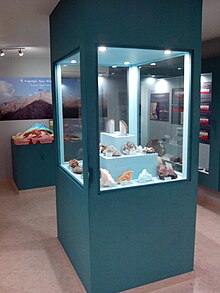Geological-historical museum of Mount Olympus
The Geological-Historical Museum of Olympus ( Greek Μουσείο Γεολογικής Ιστορίας Ολύμπου Mousio Geologikis Istorias Olymbou ) is a natural history geological museum in the central Macedonian town of Leptokarya at the foot of Mount Olympus . It presents rocks and minerals from the region and fossils from Mount Olympus and from the surrounding area in several exhibition rooms. It was set up with the help of the geological faculty of Aristotle University, Thessaloniki.
Building the museum
While exhibits from all over Greece are on display in the classrooms, a separate exhibition room is dedicated solely to Olympus. The history of the formation of the mountain is shown. Different types of rock and fossils are exhibited. Their occurrences and locations are shown using a model of Mount Olympus.
The exhibition
The geological development of Greece is explained with the help of display boards. Using a model of Mount Olympus, the distribution of the various types of rock in the mountains and their epochs are shown. All known types of rock found in Olympus are displayed in showcases.
Due to the shifting of the continental plates, Mount Olympus is still being pushed up by one to four millimeters per year. This process has been going on for millions of years. So it happens that there are petrified marine animals at an altitude of around 1000 to 1500 meters. A previously unique find was an ammonite that was found at an altitude of around 1100 meters. Other evidence that parts of the mountain were previously below sea level are limestones that were drilled by mussels ( litophagae ) or limestones that contain petrified sea worms.
Olympus is a so-called tectonic window. This means that erosion and faults have exposed ancient layers of rock that would normally be hidden. This fact ensures that geologists from all over the world travel to Olympus for research purposes.
Other panels explain that Mount Olympus only got its current shape after the Würm Ice Age. As the ice retreated, masses of debris were moved with it. This process shaped the landscape and influenced the shape of some stones. They are round on the top and flattened on the bottom.
A showcase is dedicated to petrification. Petrified plants and animals are exhibited.
So far only a few, smaller, caves have been discovered. Some of them are filled with ice that doesn't even melt in summer.
cooperation
The private museum has been cooperating with the Aristotle University of Thessaloniki since 2013 . School classes are regularly taught about the geology of Mount Olympus in two classrooms.
In the summer, the museum mainly attracts Serbian and Russian tourists.
There is the possibility of astronomical observations.
Web links
Coordinates: 40 ° 3 ′ 26.8 " N , 22 ° 33 ′ 35.9" E

